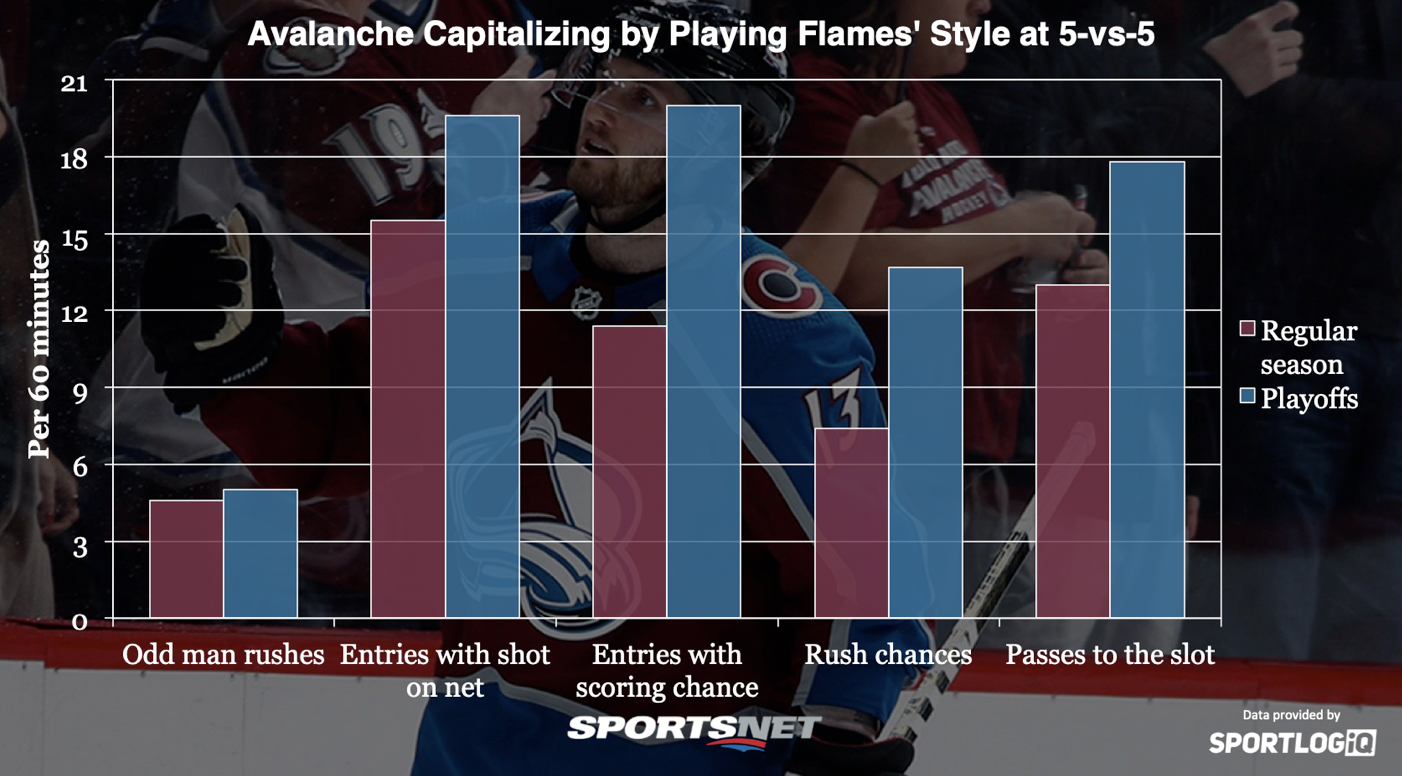In breaking down the first round series between the Calgary Flames and Colorado Avalanche before it began, the biggest area of concern for the Avalanche that I saw was the Flames’ ability to create turnovers in dangerous areas, many of which lead to odd-man rushes.
In fact, in the regular season the Flames were the league leaders in odd-man rushes per 60 minutes at 5-on-5. They were second in controlled entries per 60 overall, second in controlled entries that result in a shot on net, second in controlled entries that result in a scoring chance, and fourth in scoring chances off the rush.
Combining the Avs’ lack of defensive prowess in the neutral zone during the regular season with their high turnover numbers, it looked like this was the area Calgary would hang its cowboy hats on to ride to a commanding series win — but the series hasn’t played out that way.
[snippet id=4558775]
Just like last season when they were given a few days to pre-scout their opponent and game plan for them, the Avs have given the top-seeded team in the West absolute fits.
The Flames won the first game of the series on the back of a phenomenal shutout performance by Mike Smith, which obscured the fact that they didn’t look great in it. Since then it’s been all Avalanche, who’ve put together two excellent performances to take the series lead.
It’s clear from the way the games have gone that the Avalanche have outplayed the Flames, but how they’re doing it is truly impressive.

The Avalanche have cut down the Flames’ ability to attack off the rush by a startling degree. Colorado is allowing less than half of the odd-man rushes that the Flames averaged every 60 minutes of the regular season and have cut out about 40 per cent of their chances off the rush overall and passes to the slot. And the amount of clean zone entries that lead to a scoring chance for Calgary have dropped by nearly 60 per cent.
Colorado’s utter domination of the Flames in an area that’s Calgary’s biggest offensive strength isn’t just impressive, it’s downright shocking. The Avalanche have devised a defensive scheme that not only has limited the Flames’ ability to attack off the rush, but is also cutting down their pre-shot movement once the zone is gained.
They’ve done this without turtling into a defensive shell that has sacrificed their own offence.
In fact, the Avs haven’t changed much at all with the puck on their sticks. In the defensive zone, they’re actually turning it over more often than in the regular season, with a turnover rate of 17.3 per cent in the playoffs compared to 14.5 per cent over the 82 games preceding it.
Overall they’re turning the puck over on 18 per cent of their plays at 5-on-5, which is 0.3 per cent lower than the regular season – so, not statistically significant.
[snippet ID=3322139]
Surprisingly, the Avalanche haven’t excelled at stopping the Flames from entering their zone with control — their denial rate at the blue line is just 40 per cent, which is four and a half per cent lower than in the regular season. It’s just that once the zone is gained, the Avs aren’t giving the Flames any space at all, improving from allowing the fifth-widest gap among all regular season teams to the third-tightest gap of all playoff teams.
That extra pressure is forcing the Flames to shoot from wider angles and from further out off the rush, while the extra pressure being put on Calgary’s puck carriers has stymied their deking game as well. In the regular season the Flames were the fifth-most successful team on average at completing dekes in the offensive zone with a 45.4 per cent success rate — in the playoffs only San Jose has been less successful than the Flames’ 35.2 per cent deke success rate.
On top of shutting down all the most impactful ways the Flames create shot quality, the Avalanche have counterattacked by beating them at their own game.

Colorado’s increase in odd-man rushes in the playoffs versus the regular season seems modest, but they’ve generated the second-most of any team in the post-season. And their numbers off the rush against the Flames are absolutely ridiculous.
Every three minutes of 5-on-5 hockey the Avs are getting a scoring chance off a clean zone entry, and their rush chances are nearly double their season average.
Obviously this level of offensive performance isn’t sustainable for long, but the Avalanche only need to keep it up for two more games to best the Western Conference’s top regular season team.
It might be tempting to give all the offensive credit to Nathan MacKinnon. It’s absolutely true that he is a one-man rush scoring chance machine and leads the playoffs in that area, however he’s not the only Avs player who has been feasting on the Flames in this series.
While MacKinnon carries the biggest role on the team, Alex Kerfoot has been a revelation early in the series. While he’s on the ice the Avalanche are getting 62 per cent of the shot attempts, 57 per cent of the high danger chances, and nearly 86 per cent of the passes to the slot.
Through three games, Kerfoot’s line has been a thorn in the side of anyone they’re matched up against. In particular they’ve been trouble for Mikael Backlund’s line, which is an excellent trio, but they don’t generate as many quality looks as Johnny Gaudreau’s line.
Can the Flames rally and adjust to the Avalanche beating them at their own game? Whatever happens in this series, Colorado coach Jared Bednar has to be considered one of the best pre-series preparation coaches in the game right now.
[relatedlinks]







